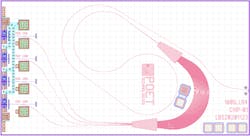Toronto-based POET Technologies Inc. (TSX Venture: PTK; OTCQX: POETF) has announced its first product for the telecommunications market, a 100G LR4 optical engine. The device, alpha samples of which should be available in the third quarter of this year, leverages the company’s POET Optical Interposer and photonic integrated circuits (PICs) to deliver lower cost and lower power consumption than available alternatives, the company asserts. The company earlier announced development of a device for CWDM4 requirements.
The Optical Interposer benefits from POET’s expertise in dielectric waveguides. While described in the past in terms that would imply application to co-packaged optics (see “POET Technologies optical interposer platform for electronic and optical component co-packaging in single MCM unveiled”), the technology also can be applied to optical transceivers, as in this implementation. Here, the optical engine converts four input channels of 25-Gbps electrical data into four LAN WDM optical signals and then multiplexes them into a single 100-Gbps optical channel. The engine is the first in a series POET plans to develop for this application; they include an Rx device as well as a combined Tx/Rx engine as well as this TX-only iteration.
“POET’s integrated monolithic multiplexer significantly reduces the cost of the optical engine, allowing us to provide a savings to customers in the range of 25%,” commented Vivek Rajgarhia, POET Technologies’ president and general manager. “By flip-chipping four DML lasers onto an Optical Interposer with inherently superior thermal management and the ability to tune the waveguides to specific center wavelengths, we are able to design an optical engine that uses 10% to 15% less power to deliver data at the same speed and over the same distance as comparable modules.”
The engines will pair with 25-Gbps directly modulated lasers (DMLs) from Sanan Integrated Circuits. The lasers have been independently tested and validated to operate to LR4 specifications and are in qualification, according to POET. Sanan also will source the monitor photodiodes and the high-speed photodiodes that complete the bill of materials for the optical engine.
Production will take place at Super Photonics Xiamen (SPX), a joint venture between POET and Sanan. SPX has received the equipment necessary to assemble the optical engines, an endeavor that should begin later this quarter, POET states. The company says it has signed a pair of alpha customers for the first samples.
For related articles, visit the Optical Technologies Topic Center.
For more information on optical modules and suppliers, visit the Lightwave Buyer’s Guide.
To stay abreast of optical communications technology, subscribe to Lightwave’s Enabling Technologies newsletter.
